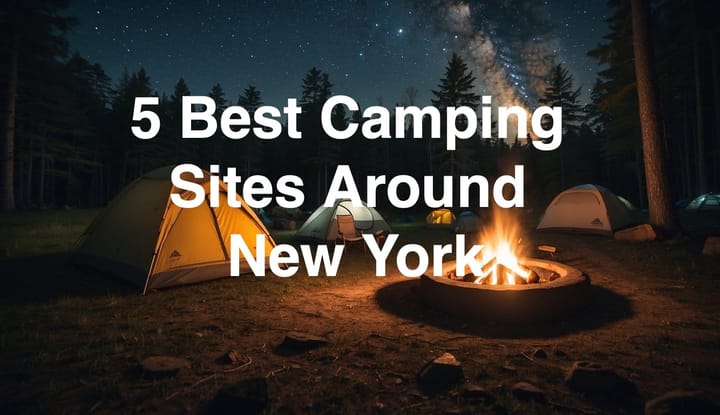How to Pack for Camping
Embarking on a camping adventure allows you to connect with nature and take a break from the hustle and bustle of daily life. However, packing for a camping trip can be daunting, especially for beginners.

Proper planning and having the right essentials are crucial for a comfortable and enjoyable experience.
In this article, we'll guide you through packing for a camping trip, considering factors such as the trip's duration, location, and planned activities.
By understanding what to prioritize and how to pack your gear efficiently, you'll be well-equipped to make the most of your outdoor escapades.
Just remember always to put safety first and enjoy the great outdoors!
Needed Camping Equipment
Gear Essentials
When packing for a camping trip, prioritizing the essential gear is crucial to ensure a comfortable and enjoyable experience.
Begin by selecting a suitable tent and sleeping bag according to the weather conditions and your preferences.
A quality backpack is essential to carry your belongings, while a headlamp or lantern will provide necessary illumination at night.
Don't forget to pack a reliable knife for multiple uses and a portable stove for cooking meals at your campsite.
Invest in a well-stocked first-aid kit to address any medical emergencies.
A durable water bottle will keep you well-hydrated, and a thorough camping checklist will ensure you have all the necessary gear for a successful trip.
With these essentials, you'll be well-prepared for a memorable and worry-free camping adventure.

Essential Clothing for Camping
Footwear
It's crucial to choose the appropriate footwear for your camping trip.
Bring hiking shoes or boots for challenging terrain, and always pack an extra pair of comfortable shoes around the campsite.
Don't forget to pack moisture-wicking socks to keep your feet dry and blister-free during outdoor adventures.
Layering
Layering is essential when it comes to dressing appropriately for camping. Start with moisture-wicking underwear and a lightweight shirt or pants as your base layer.
Add an insulating jacket or vest for warmth, and pack a waterproof rain jacket for unexpected weather conditions.
In colder climates, include gloves for added protection. Lastly, pack a swimsuit for your aquatic activities if you plan to swim.
Packing Hygiene and Toiletries
Personal Hygiene
When packing for camping, maintaining personal hygiene is essential.
Include biodegradable soap, a toothbrush, and toothpaste for your oral care and cleaning needs. Keep in mind that biodegradable soap is crucial to minimize your environmental impact.
Remember to add toilet paper and hand sanitizer to your hygiene essentials.
Not only will these items help keep you clean and sanitized, but they will also provide comfort during your camping experience.

Food and Drink for Camping
Cooking Utensils
Keeping your cooking equipment simple when packing for a camping trip is essential.
Bring essentials like a cutting board, plates, cups, and tongs.
A portable stove, camping pot, and a few essential cooking utensils, such as a spatula and a knife, will also be helpful.
Opt for lightweight and compact tools to minimize your cooking efforts and maximize your enjoyment of the outdoors.
This will ensure you have everything you need without carrying too much weight.
Meal Ideas
For camping meals, focus on non-perishable, easy-to-cook, and nutritious options.
You may want to pack dry foods like crackers, bread, cereal, granola and wet foods like meats, dairy, fruits, and vegetables.
Remember to separate them and store them in airtight containers or resealable bags.
Ensure you have a reliable cooler for storing perishable items, and use ice packs or frozen water bottles to keep the contents cold.
Pack charcoal for your camping stove or campfire, and always bring plenty of water for drinking, cooking, and cleaning.
Keeping these items in mind ensures you have everything you need for a successful and enjoyable camping trip.

Camping Comfort Items
Sleep Comfort
A quality sleeping pad, such as the Sea to Summit's comfortable model or an air mattress, can dramatically enhance your sleeping experience while camping.
Don't forget to bring pillows for added comfort, either by using dedicated camping pillows or repurposing those from home.
Seating Comfort
Regarding seating, collapsible camping chairs provide a convenient and comfortable solution.
For the ultimate relaxation option, consider bringing a hammock to enjoy downtime at your campsite, as it's a great way to unwind and take in the sounds of nature.
To elevate your camping experience even more, portable camping cots can offer an alternative restful spot to read, nap, or chill out during the day.
Seasonal Considerations for Camping
Cold Camping
When camping in cold weather, it's essential to have a suitable sleeping bag rated for low temperatures.
Consider an insulated, thermal sleeping bag with a hood to keep you warm and comfortable during the night.
Additionally, keep a fleece blanket on hand for added warmth and insulation.
Layering is vital when dressing for cold weather camping. Start with moisture-wicking thermal base layers like wool, polyester, or nylon.
Remember to wear high-quality outerwear, gloves, and headgear to protect yourself from wind, snow, and rain.

Warm Camping
Choose a breathable, lightweight sleeping bag in warmer climates to provide adequate ventilation.
Ventilating zippers on your sleeping bag can help create airflow and regulate body temperature during warm nights.
Pack a thin, breathable blanket for added comfort if temperatures drop during the night.
For warm-weather camping, it's essential to wear loose, light-colored clothing that promotes airflow and wicks away sweat.
Opt for moisture-wicking fabrics like polyester and nylon.
Don't forget your sun protection essentials, including a wide-brimmed hat, sunglasses, and sunscreen, to shield you from the sun's harmful rays.
Safety Precautions
Safety Devices
When packing for camping, it's crucial to include essential safety devices. Equip yourself with a flashlight and extra batteries to navigate your surroundings in the dark.
In addition, a compass will help you find your way if you get lost.
Don't forget a first aid kit containing essential medical supplies such as bandages, antiseptic wipes, and pain medication.
Lastly, pack waterproof matches or a lighter for starting fires in any weather conditions.
Preventive Measure
Before heading out on your camping trip, research the area where you'll be staying.
Familiarizing yourself with potential hazards, such as risky terrain or local wildlife, will help you stay safe.
Moreover, always camp at least 25 feet away from any structure or flammable materials.
When handling food, practice proper food safety by washing your hands, keeping raw and cooked food separate, and storing perishable items in insulated coolers.
Adhering to these safety practices will significantly reduce the chances of encountering issues during your camping adventure.
Frequently Asked Questions
What items are essential for beginner campers?
As a beginner camper, essential items include a tent with a footprint, a sleeping bag, and a sleeping pad or air mattress. Bring a backpack or duffle bag, a headlamp or flashlight with extra batteries, and a camping stove for cooking.
What should be included on a family camping checklist?
For a family camping trip, ensure a spacious tent, adequate sleeping gear, a first aid kit, and essential cooking equipment. Also, pack clothes suitable for the weather, food and snacks, sunscreen, insect repellent, and entertainment options like board games or playing cards.
Which camping equipment is necessary for a successful trip?
Necessary camping equipment includes shelter (tent or hammock), sleeping gear (sleeping bags, pads, or air mattresses), cooking essentials (camping stove, cookware, and utensils), and personal items (clothing, toiletries, and medications). Don't forget critical accessories like a first aid kit, a multi-tool, and navigation tools (maps, compass, or GPS).
What are the ten must-haves for any camping adventure?
The ten must-haves for a camping adventure are 1) a tent, 2) a sleeping bag, 3) a sleeping pad or air mattress, 4) a camping stove, 5) cookware and utensils, 6) suitable clothing, 7) a first aid kit, 8) a headlamp or flashlight, 9) a multi-tool or pocket knife, and 10) a map and compass or GPS for navigation.
How can one plan clothing and food for a 3-day camping trip?
For a 3-day camping trip, pack clothing that can be easily layered to adapt to changing weather conditions, such as moisture-wicking base layers, insulating mid-layers, and waterproof outer layers. Plan your meals by creating a simple menu of breakfasts, lunches, dinners, and snacks, accounting for non-perishable items or those with longer shelf lives.


